Art World
What Happens to PS1’s Young Architect’s Program Projects at the End of the Summer?
Do they go to Abu Dhabi? We find out.
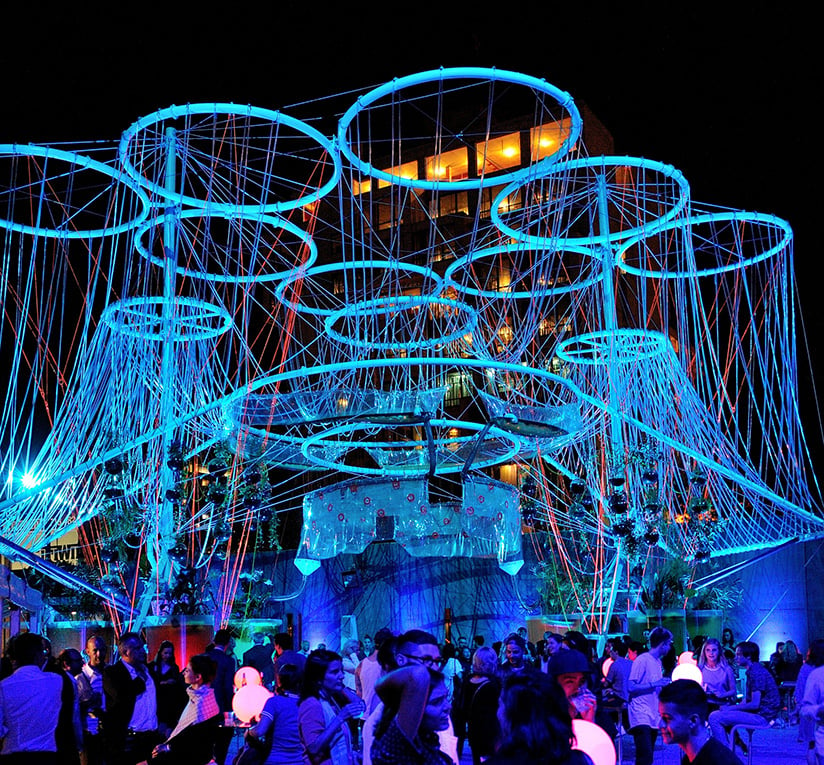
Do they go to Abu Dhabi? We find out.

Clara Zevi

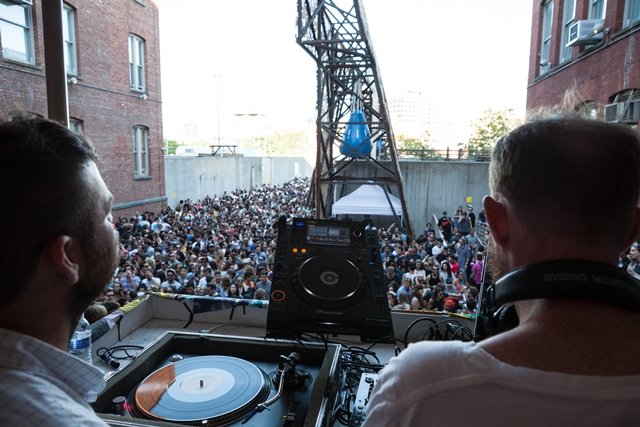
Warm Up 2013.
© 2013 MoMA PS1; Photo: Zachary Newton.
For nearly two decades, the Young Architect’s Program (YAP) has brought both young and established talent to MoMA PS1’s courtyard to form a welcome space for overheated crowds that often interact with the work during the institution’s popular Warm Up series.
Each spring since the late 1990s, a panel formed of MoMA and MoMA PS1 senior staff, as well as faculty from the nation’s top architecture programs, selects a firm to design and build a structure for the summer visitors.
So what happens to the pavilions and their creators once the DJs pack up their gear, the throngs of people leave, and the summer is over?
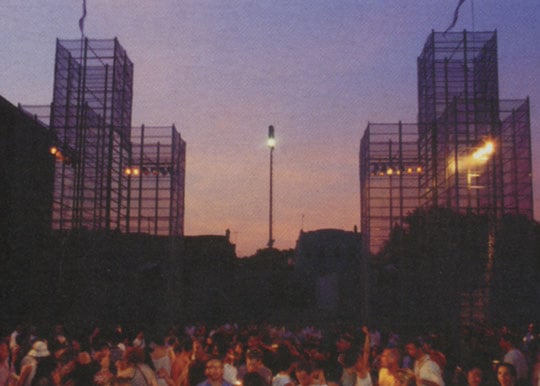
Crowds gathered to see Philip Johnson’s design.
Image: MoMA PS1.
1999, Philip Johnson “Dance Pavilion”
Philip Johnson was the second architect chosen for the program, following a project by the Viennese art group Gelatin that transformed the space into an adult playground.
When he won the prize, Johnson was already an award-winning architect and MoMA veteran. He had begun working with the museum decades before it partnered with PS1, becoming the Director of the Architecture Department at MoMA in the 1930s and later designing its Sculpture Garden.
For the PS1 project, he built a huge DJ platform that housed the likes of electronic music star Russell Haswell. Five towers over 50 feet high made of lightweight scaffolding created the backdrop for a series of movie screenings and performances.
“This pavilion captures the spirit of PS1’s summer festival. It’s a disco for the 21st century—a medieval amphitheater with a science-fiction feeling,” Johnson told MoMA of his pavilion.
Soon after the work came down, Johnson was invited to Case Western Reserve University in his hometown, Cleveland, Ohio. Here, while receiving a dedication for a sculpture he had built for the campus, 94-year old Johnson condemned the school for no longer having an architecture program.
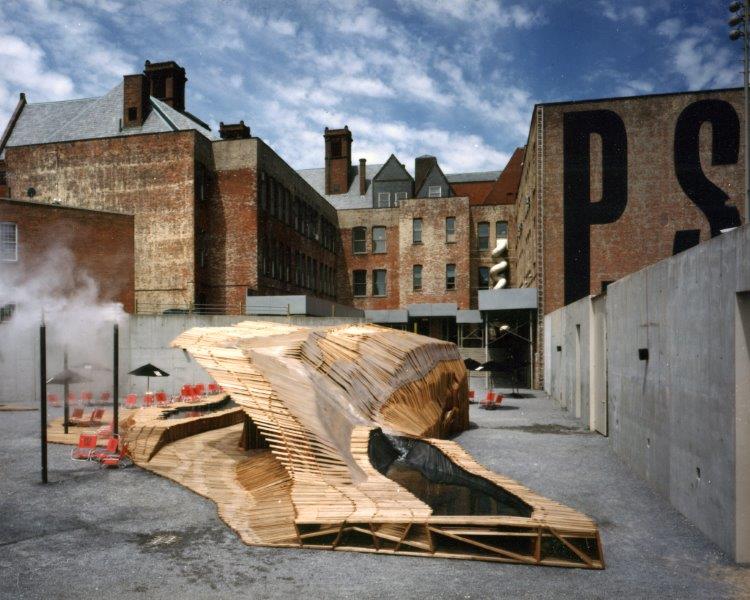
SHoP Architects came up with the ‘urban beach’ concept for the MoMA PS1 courtyard.
Image: David Joseph.
2000, SHoP Architects “Dunescape”
SHoP’S winning design confirmed that creating a beach in Long Island City was actually possible—sort of.
“We had three weeks to design it and three weeks to build it.” SHoP Principal, Gregg Pasquarelli, told artnet News in an interview. “We had to take something very standard and try and make something magical happen. The whole pavilion was modeled on the idea that surface, structure and program could be blended into a single thing that would then become a kind of sculpture.”
“There were secret compartments that you could climb inside. You could go in them and make out and nobody could see you but you could see everybody,” Pasquarelli said.
Once the hot summer days were over, the materials were packed up and put to good use. “The ceder wood members were donated to a trade school to be used to train woodworkers,” Pasquarelli explained.
The firm recently designed the Barclays Center in Brooklyn and is currently constructing Uber’s headquarters in San Francisco.

Tom Wiscombe’s winning design.
Image: Tom Wiscombe Architecture.
2003, Tom Wiscombe Architecture “Urban Beach”
In 2003, Tom Wiscombe built Urban Beach, a set of shallow pools covered by a semi-transparent roof that lit up at night. The firm is currently developing a futuristic design for a museum project in Downtown Los Angeles.
“I think this is the next stage of evolution for Los Angeles into a world city,” Wiscombe said of his latest project. “There are some formal similarities between the PS1 [project] and the design for the museum, in the sense that the objects are based on pseudo-primitives and their containers,” he told artnet News via email.
After the summer, Urban Beach was sold for scrap. “It was chopped up and recycled since it was all aluminum pipe and mesh. That was one of our original ideas for keeping costs down—that we sell the aluminum back to a local metals company,” said Wiscombe.
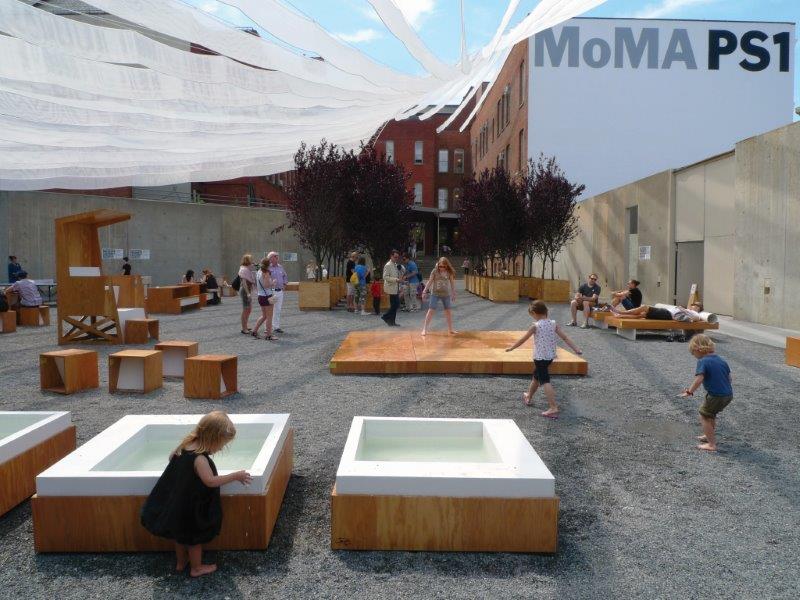
Interboro’s project focused on what the local community could use once the structure had to come down.
Image: Interboro Partners.
2011, Interboro Partners “Holding Pattern”
Interboro was the first firm to directly reach out to the surrounding residents and ask what they could do to improve the area after the summer hype had cooled down.
The project began with a question, Dan D’Oca, Principal at Interboro, told artnet News via email. “Instead of designing and building an object that would end up in the dumpster, what if we designed an installation out of objects that people in the neighborhood needed?”
Interboro met with school teachers, representatives of senior citizen centers, librarians and those in charge of the local post offices and public housing projects. Together they made a list of what everyone wanted. Mike, the manager of a taxi stand opposite MoMA PS1, suggested that ping pong would be a fun activity for the cab drivers during their breaks. “We could ‘hold’ the objects in the courtyard during the summer, where they would be enjoyed by patrons of the Warm Up, then give them to their rightful owners in the fall,” said D’Oca.
Interboro adopted a similar model in its project for the American Pavilion at the 2011 Venice Biennale. “To ensure that the platform would be reused when the Biennale was over, we designed it according to the specs of the temporary, elevated sidewalks that Venetians use to navigate the city during aqua alta called passarelle. When the project was deinstalled, the passarelle were donated to the city of Venice.”
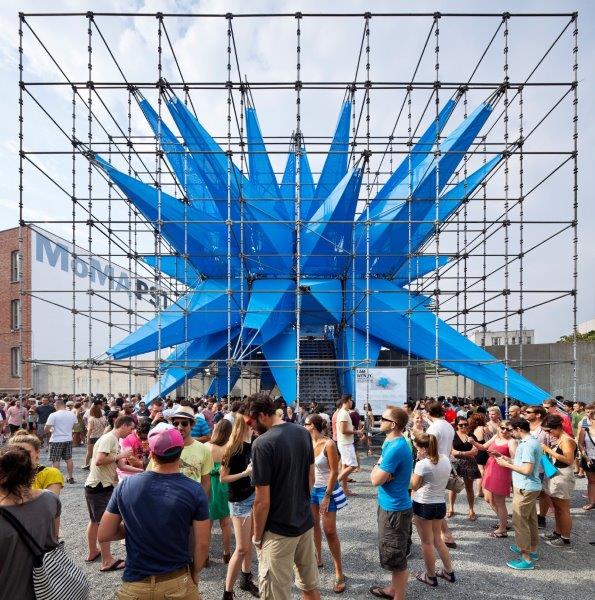
HWKN’s Wendy was a bright and energetic structure contained in a cube of scaffolding.
Image: Michael Moran & HWKN.
2012, HWKN “Wendy”
HWKN built Wendy, a spiky blue structure encased in scaffolding. Her job over the summer was to rid the atmosphere of the same amount of fumes produced by 260 cars.
“Wendy was covered in titania nanoparticles that sucked pollution out of the air. But she also had these giant fans that pushed the clean air out. It literally would slap people across the face with air,” HWKN co-founder, Marc Kushner, explained to artnet News during a phone interview.
He continued, “It’s not enough for buildings to use less energy. What we tried to do was fix the environment around us.”
Wendy’s next stop was Abu Dhabi, where she was taken by a philanthropic sheik for Abu Dhabi Sustainability Week.
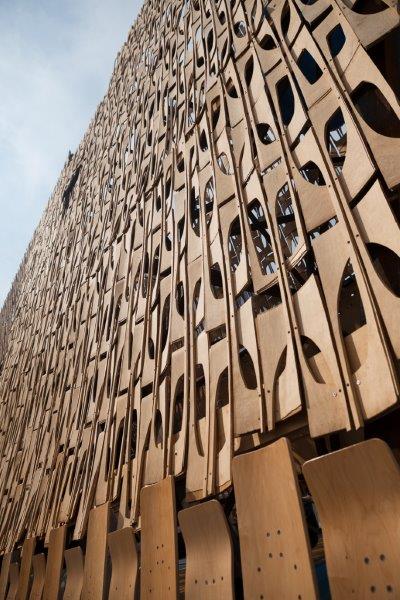
Close up of CODA’s ‘Party Wall’.
Image: Zachary Tyler Newton.
2013, CODA “Party Wall”
Irish-born architect and academic Caroline O’Donnell brought text into the MoMA PS1 courtyard with Party Wall, a screen of skateboards that spelled out the word WALL upside-down.
“Party Wall read as a kind of digital pattern, one that we’ve seen over and over. But on closer inspection, the skateboard cut-out became visible, until finally that perception was overtaken by the skateboard as bench: so the façade was constantly shifting in what it appeared to be,” O’Donnell told artnet News via email.
Once the summer heat was over, the firm returned and donated all of the wall’s materials. “I heard that some of the water ballast bladders ended up as water storage tanks on an eco-farm in New Jersey,” said O’Donnell.
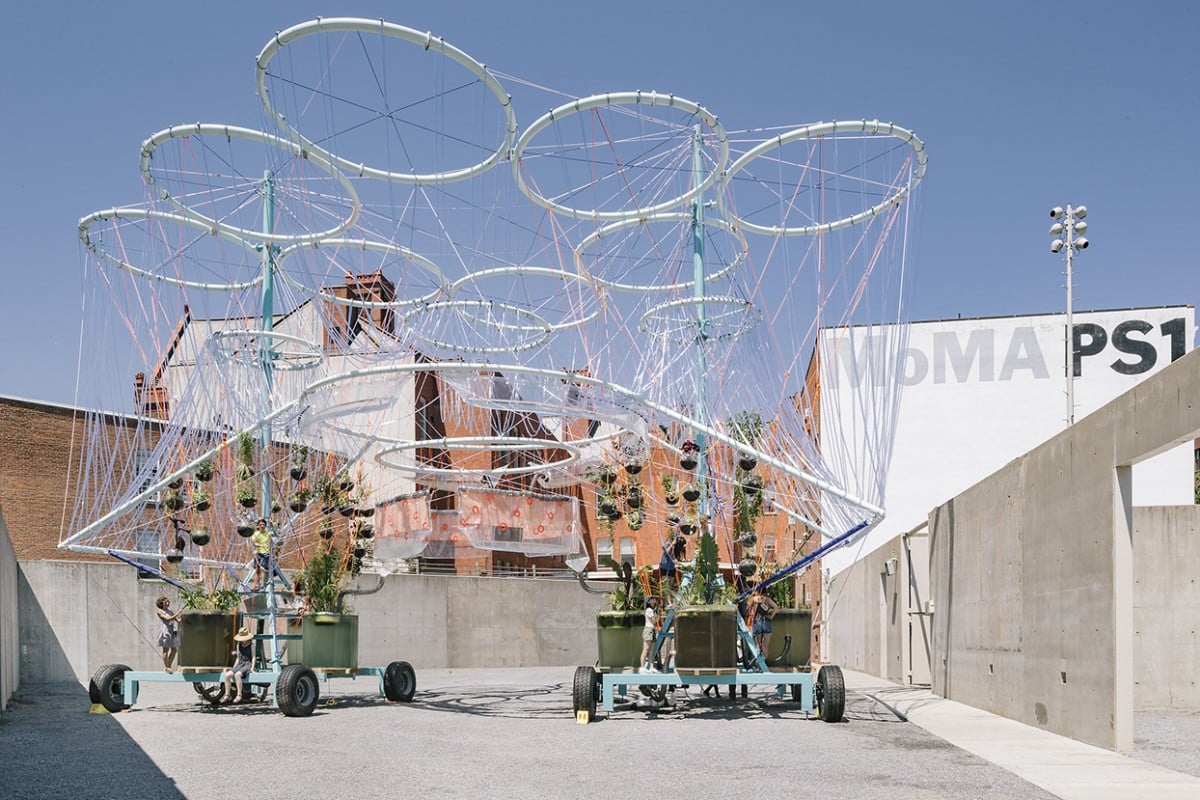
This year’s pavilion by Andrés Jaque.
Image: MoMA PS1.
2015, Andrés Jaque “COSMO”
This year’s prizewinner, Andrés Jaque, designed COSMO, a structure that has been filtering thousands of gallons of water throughout the summer months.
Not just a one-time installation, the purification system is a model that can be easily rebuilt and moved to the next eco-friendly spot. “COSMO is a prototype of many interventions to come,” a robotic voice promises on the firm’s website.
Not only can Andrés Jaque’s invention be remade in various configurations, but its leftovers can be reused after it is disassembled. According to the website, “Once the summer finishes, the plants will be adopted by neighbors [who] will expand COSMO’s intelligence to their windows, their rooftops and their gardens. It is an open prototype.”
Related Stories:
See Exciting New Design Proposals for New York’s Aging LaGuardia Airport
New York’s 15 Can’t-Miss Summer Public Art Installations
Landmarks Commission Rejects Aby Rosen’s Proposal for Four Seasons Interior – Good Call
Government Enshrines Right of New Yorkers to Complain About and Stop Ugly Public Art